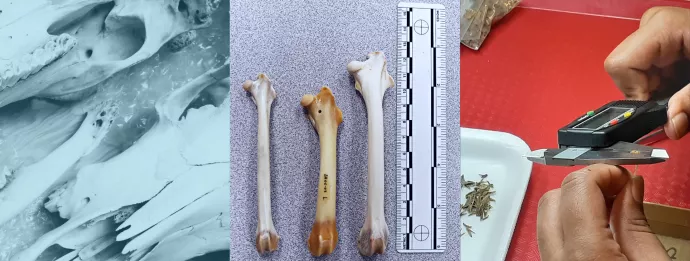
Teaching
We offer an upper level undergraduate course in zooarchaeology at UTM. Taught by Michael Brand, ANT415 aims to introduce students to vertebrate osteology and methods of identification and analysis. Alicia Hawkins supervises graduate and undergraduate projects (ROP, work study) on zooarchaeology.
Zooarchaeology Lab and Collection
The UTM Zooarchaeology Lab and the Deborah J. Berg Faunal Collection is managed by Trevor Orchard.
UTM Zooarchaeology Lab and Collection
Research and Publications
We have active collaborative research projects in several areas:
Zooarchaeological Methods
We ask: How do decisions about identification and recovery impact the datasets we generate? Are zooarchaeological data generated by inexperienced analysts reliable? What is the effect of use of fine-meshed sieves on the diversity of identified taxa?
Publications
2022 Hawkins, Alicia L., Michael Buckley, Suzanne Needs-Howarth, and Trevor J. Orchard. Practice Makes Perfect? Inter-Analyst Variability in the Identification of Fish Remains from Archaeological Sites. International Journal of Osteoarchaeology 32(3): 694-705.
Draft Hawkins, Alicia L., Suzanne Needs-Howarth, Trevor J. Orchard, Frances L. Stewart, Eric Tourigny, Eric Guiry. Recommendations for zooarchaeology in Ontario Archaeology. (PDF) Ontario Archaeological Society Recommendations for zooarchaeology in Ontario archaeology (researchgate.net)
In Press Friesen, T. Max, Alicia L. Hawkins, Suzanne Needs-Howarth, Trevor J. Orchard, and Frances L. Stewart. The Unanticipated Legacy of Howard G. Savage: Reflections on Teaching, Learning, and Practising Zooarchaeology in Ontario. Canadian Journal of Archaeology, special issue., edited by Amy Fox and Michael Chazan.
Meta-analysis
In this research we investigate patterns in human interactions with other animal species over time in Ontario. We use identifications that have been generated by many zooarchaeologists, which are currently in grey literature reports. We ask if there are trends we can see in the presence of different species.
Publications
2023 Orchard, Trevor J. , Alicia Hawkins, Suzanne Needs-Howarth, Louis Lesage, Eric Guiry, and Thomas C.A. Royle. Considering Extinct, Extirpated, and Endangered Species in the Zooarchaeological Record of Southern Ontario. ArchNotes: Newsletter of the Ontario Archaeological Society 28(1-2): 5-22.
2023 Orchard, Trevor J., Suzanne Needs-Howarth, Alicia L. Hawkins, Louis Lesage, Eric J. Guiry, Thomas C. A. Royle. Considering Passenger Pigeon Abundance and Distribution in the Late Woodland zooarchaeological record of southern Ontario, Canada. International Journal of Osteoarchaeology 33(4): 608-618.
2019 Hawkins, Alicia L., Suzanne Needs-Howarth, Trevor Orchard, and Eric Guiry. Beyond the Local Fishing Hole: A Preliminary Study of Pan-Regional Fishing in Ontario (ca. 1000 CE to 1750 CE). Journal of Archaeological Science: Reports 24:856–868.
Historical Ecology
How can zooarchaeology help us to understand changing ecosystems? Through use of stable isotope analysis and ancient DNA, we can learn more about species in the Ontario region and how their populations, presence or distribution may have changed over time.
Publications
2020 Guiry, Eric J., Michael Buckley, Trevor J. Orchard, Alicia L. Hawkins, Suzanne Needs-Howarth, Erling Holm, and Paul Szpak. Deforestation caused abrupt shift in Great Lakes nitrogen cycle. Limnology & Oceanography 65: 1921-1935.
2020 Royle, Thomas, Hua Zhang, Eric J. Guiry, Trevor Orchard, Suzanne Needs-Howarth and Dongya Yang. Investigating the sex-selectivity of a middle Ontario Iroquoian Atlantic salmon (Salmo salar) and lake trout (Salvelinus namaycush) fishery through ancient DNA analysis. Journal of Archaeological Science: Reports 31(3): 102301.
2016 Guiry, Eric J., Suzanne Needs-Howarth, Kevin D. Friedland, Alicia L. Hawkins, Paul Szpak, Rebecca Macdonald, Michelle Courtemanche, Erling Holm, and Michael P. Richards. Lake Ontario Salmon (Salmo salar) Were not Migratory: A Long-Standing Historical Debate Solved Through Stable Isotope Analysis. Scientific Reports 6:36249.
